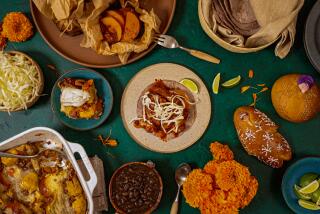Out of the Fountain
- Share via
Lunch came early during those Central Valley summers. We started work at 7:30 a.m., moving sprinklers and whacking weeds at my high school campus. We broke for a midday meal at 11, knowing that by 3 p.m. it would be 105 degrees and time to scurry into the shade like desert insects.
Cold drinks were at a premium. I usually packed a can of root beer or Dr Pepper, a forgivable crime for a 14-year-old. But I soon discovered that what I really wanted was an iced glass of the white, milky beverage one of my co-workers brought daily in a tall jar. “Rice Kool-Aid,” he called it, and that seemed about right when I sampled it. What he had was horchata, that classic Mexican drink made of rice, milk, water and cinnamon. Imagine my glee when I began to notice the concoction in Los Angeles take-out restaurants, stationed next to the lemonade or jamaica (made from steeped hibiscus petals) and gushing profusely, like a perpetual high-caloric geyser in one of those weird soft-drink fountains.
The word horchata seems to be etymologically linked to the French orgeat (originally a barley beverage, now a syrup derived from almonds and orange flower water) and the Italian orzata (meaning almond). Horchata is an ancient elixir, introduced to Spain by the Moors during their 8th-century conquest. But the Mediterranean version, still exalted in the Valencia region, is not ours. It’s made from chufa (also known as tiger nut), the tuberous root of a certain sedge. If you want to try horchata de chufa, richer and a little nutty, you can purchase an imported liter from La Espanola Meats in Harbor City.
In makeup, Mexican horchata is much closer to rice caudle, an old American quaff described in the 1860 book “Practical Housewife.” For practical housewives and househusbands of the new millennium, Mexican horchata is a great addition to parties. During the warmer months, I find myself constantly foisting margaritas and rum punch on my guests. Not everybody desires a cocktail, of course (nonalcoholic margarita mix gives my 7-year-old a headache), so it’s nice to have a buzz-free alternative. Horchata is hard to beat for efficiency and consistent satisfaction.
In searching for a recipe, I wound up in “Frida’s Fiestas,” a cookbook co-written by legal professor Guadalupe Rivera--Frida Kahlo’s stepdaughter and daughter of Diego Rivera and his first wife, Lupe Marin. In the grand tradition of the bohemian upper crust, the Rivera stepfamilies remained close, even living under a single roof at one point. Their meals, as described by Guadalupe, were stylized epics.
Kahlo, who is about to bear a striking resemblance to Salma Hayek, called September “the patriotic month.” In celebrating Independence Day, she demonstrated her national fervor by mixing three drinks to symbolize the Mexican flag: red jamaica, green lime water and white rice water, a.k.a. horchata.
Some recipes include condensed milk or almond flour or vanilla. Frida’s is pleasingly basic. And heck, if it was good enough for Leon Trotsky and David Alfaro Siqueiros, it’s good enough for me.
*
Horchata
Serves 8 to 10
3 cups rice
3 cups milk (dairy or soy)
3 cinnamon sticks, broken into pieces and lightly toasted in a skillet
1 1/4 cups sugar
6 cups water
Cover rice (by at least an inch) in water and soak for 3 hours. Drain rice and puree in blender with milk and cinnamon. Strain mixture, discarding rice paste and reserving liquid. In separate bowl, dissolve sugar in water. Combine rice liquid and sugared water, stir well and serve over ice.
*
Phil Barber last wrote for the magazine on creme brulee.
*
Resource Guide
ENTERTAINING, Page 27: La Espanola Meats, Harbor City, (310) 539-0455.
More to Read
Eat your way across L.A.
Get our weekly Tasting Notes newsletter for reviews, news and more.
You may occasionally receive promotional content from the Los Angeles Times.










